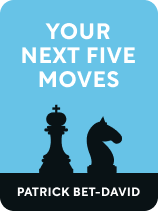

This article is an excerpt from the Shortform book guide to "Your Next Five Moves" by Patrick Bet-David. Shortform has the world's best summaries and analyses of books you should be reading.
Like this article? Sign up for a free trial here .
How well do you know yourself? If you understood yourself better, how would your long-term success be affected?
In his book Your Next Five Moves, Patrick Bet-David outlines five steps toward enduring success. He believes that the first step of your strategic plan is to understand yourself. Bet-David identifies three steps in this self-discovery process: understand who you are now, understand who you want to be in the future, and understand how to get there. His principles can easily be applied to life in general.
Continue for details on how to know yourself better.
How to Know Yourself Better
If you want to learn how to know yourself better, take a look at these three steps in Bet-David’s process of self-discovery.
Step #1: Understand Who You Are Now
Understand who you are now because this allows you to accept yourself fully, writes Bet-David. Only when you accept yourself can you begin to confidently pursue goals and paths aligned with your truest desires and greatest strengths.
(Shortform note: Bet-David proposes you learn about yourself but doesn’t propose specific aspects of your personality to understand. You could assess yourself based on the Big Five personality dimensions: extraversion, neuroticism, agreeableness, conscientiousness, and openness to experience. Each dimension exists on a spectrum, meaning you fall somewhere on the spectrum between high and low neuroticism, for instance. It seems that both your genetics and environmental factors affect where you land on the spectrum for each dimension and that your traits don’t change much over the course of your adult life. Learning how much of each trait you possess may help you set goals that better suit who you are.)
How to Understand Who You Are
To understand who you are, Bet-David advises asking yourself probing questions, like: How does the world see you, and how does that differ from how you see yourself?
(Shortform note: Asking probing questions is more than a way to get to know yourself: Posing a series of increasingly personal questions is a recommended way for two people to develop rapid intimacy.)
Also, consider which of the following four factors motivates you most: accomplishment (the desire to reach a goal), uniqueness (the desire to live life on your terms), hustle (the desire to compete and prove others wrong), or duty (the desire to positively impact the world).
(Shortform note: In Drive, Daniel Pink proposes a different, arguably simpler way to categorize human motivation. He argues that some people are more motivated by external rewards—money, recognition, and so on—and others are motivated by internal rewards—an intrinsic desire to get better at something. He adds that those motivated by internal rewards have greater sustained success.)
Step #2: Understand Who You Want to Be in the Future
Once you understand who you are and what matters to you now, figure out who you want to be in the future, writes Bet-David. Your strategic steps depend entirely on what future you want to achieve, so reflecting on this is key. Bet-David adds that it’s fine not to know this clearly right now, as long as you dedicate energy toward thinking about the question.
(Shortform note: Bet-David advises understanding who you want to become but doesn’t provide advice on how to do this. Richard Nelson Bolles’s What Color Is Your Parachute? contains a self-reflective exercise that can guide you toward your ideal future career, specifically. The exercise asks you to consider seven facets of your personality: your sociability, preferred workplace, assets, life goals, your existing knowledge, preferred salary, and where you want to live. Your answers should inform the career direction you take.)
Bet-David claims that it’s not enough to know who you want to be in the future: Behave now like the person you want to become. Even if you don’t have the resources to realize your future goals, acting as if they’re a reality gives you the mindset to accomplish them. For example, if you aspire to own your own successful pet store, start behaving like a business owner now by talking up your business idea to others, consuming industry news, and attending industry networking events.
(Shortform note: In Atomic Habits, James Clear takes a different approach to personal change than Bet-David. While Bet-David advises acting as if you already possessed all the good habits you one day wish to have, Clear argues that to develop good habits and become the person you want to be, you should make small, incremental changes to your behavior. These small changes that add up over time may be easier to achieve than Bet-David’s total mindset shift.)
Step #3: Understand How to Get There
Finally, pursue business ventures aligned with what your strengths are and who you want to be, writes Bet-David. The best place to do this is in untapped markets where you have unique strengths. For example, if you’re passionate about animals and want to start a pet supplies business, you might focus on the untapped market of pets with disabilities using your personal experience of having a dog with a disability.
(Shortform note: Bet-David advises you to start your identity-aligned business in an untapped market where you have unique skills. But how can you shift to this new market if you currently work in an industry or position that isn’t aligned with your identity and strengths? In The Science of Getting Rich, Wallace D. Wattles argues that you can make your desired career transition by strengthening your current business or position so that new opportunities open up to you. For instance, if you own a business unaligned with who you want to become, strengthen your company so you can sell it and start fresh in your niche of choice.)

———End of Preview———
Like what you just read? Read the rest of the world's best book summary and analysis of Patrick Bet-David's "Your Next Five Moves" at Shortform .
Here's what you'll find in our full Your Next Five Moves summary :
- What distinguishes exceptional business leaders from average ones
- The five strategic steps you must start taking for long-term success
- How to track your business' growth metrics






